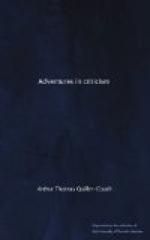FOOTNOTES:
[A] The opening lines of the second stanza of this poem have generally been printed thus:
“Primrose, firstborn child
of Ver,
Merry springtime’s harbinger,
With her bells dim....”
And many have wondered how Shakespeare or Fletcher came to write of the “bells” of a primrose. Mr. W.J. Linton proposed “With harebell slim”: although if we must read “harebell” or “harebells,” “dim” would be a pretty and proper word for the color of that flower. The conjecture takes some little plausibility from Shakespeare’s elsewhere linking primrose and harebell together:
“Thou shalt not lack
The flower that’s like thy face, pale primrose, nor
The azured harebell, like thy veins....”
Cymbeline, iv. 2.
I have always suspected, however, that there should be a semicolon after “Ver,” and that “Merry springtime’s harbinger, with her bells dim,” refers to a totally different flower—the snowdrop, to wit. And I have lately learnt from Dr. Grosart, who has carefully examined the 1634 edition (the only early one), that the text actually gives a semicolon. The snowdrop may very well come after the primrose in this song, which altogether ignores the process of the seasons.
SAMUEL DANIEL
February 24, 1894. Samuel Daniel.
The writings of Samuel Daniel and the circumstances of his life are of course well enough known to all serious students of English poetry. And, though I cannot speak on this point with any certainty, I imagine that our younger singers hold to the tradition of all their fathers, and that Daniel still
renidet in angulo
of their affections, as one who in his day did very much, though quietly, to train the growth of English verse; and proved himself, in everything he wrote, an artist to the bottom of his conscience. As certainly as Spenser, he was a “poet’s poet” while he lived. A couple of pages might be filled almost offhand with the genuine compliments of his contemporaries, and he will probably remain a “poet’s poet” as long as poets write in English. But the average reader of culture—the person who is honestly moved by good poetry and goes from time to time to his bookshelves for an antidote to the common cares and trivialities of this life—seems to neglect Daniel almost utterly. I judge from the wretched insufficiency of his editions. It is very hard to obtain anything beyond the two small volumes published in 1718 (an imperfect collection), and a volume of selections edited by Mr. John Morris and published by a Bath bookseller in 1855; and even these are only to be picked up here and there. I find it significant, too, that in Mr. Palgrave’s Golden Treasury Daniel is represented by one




